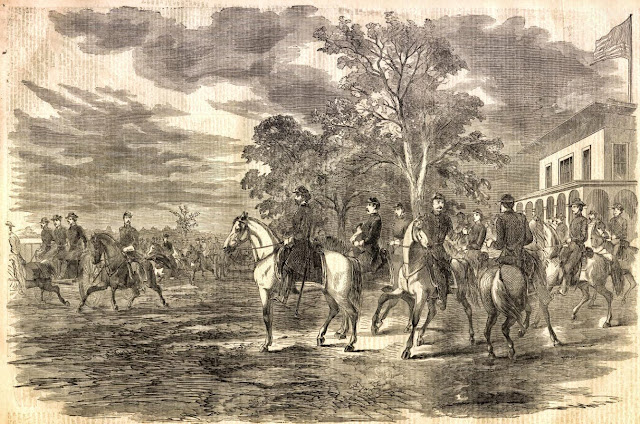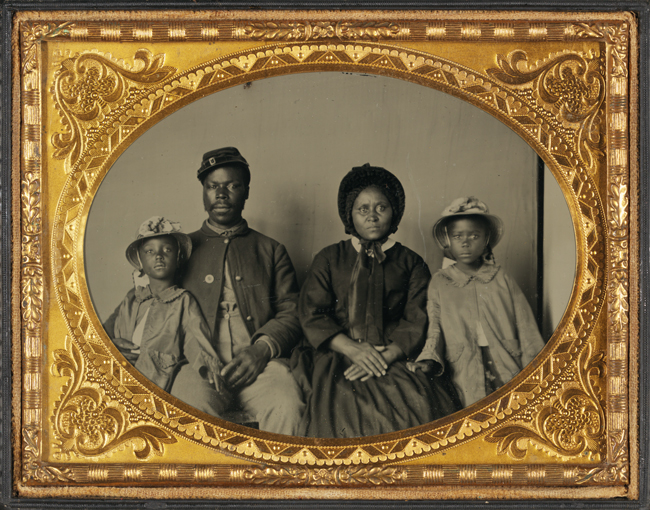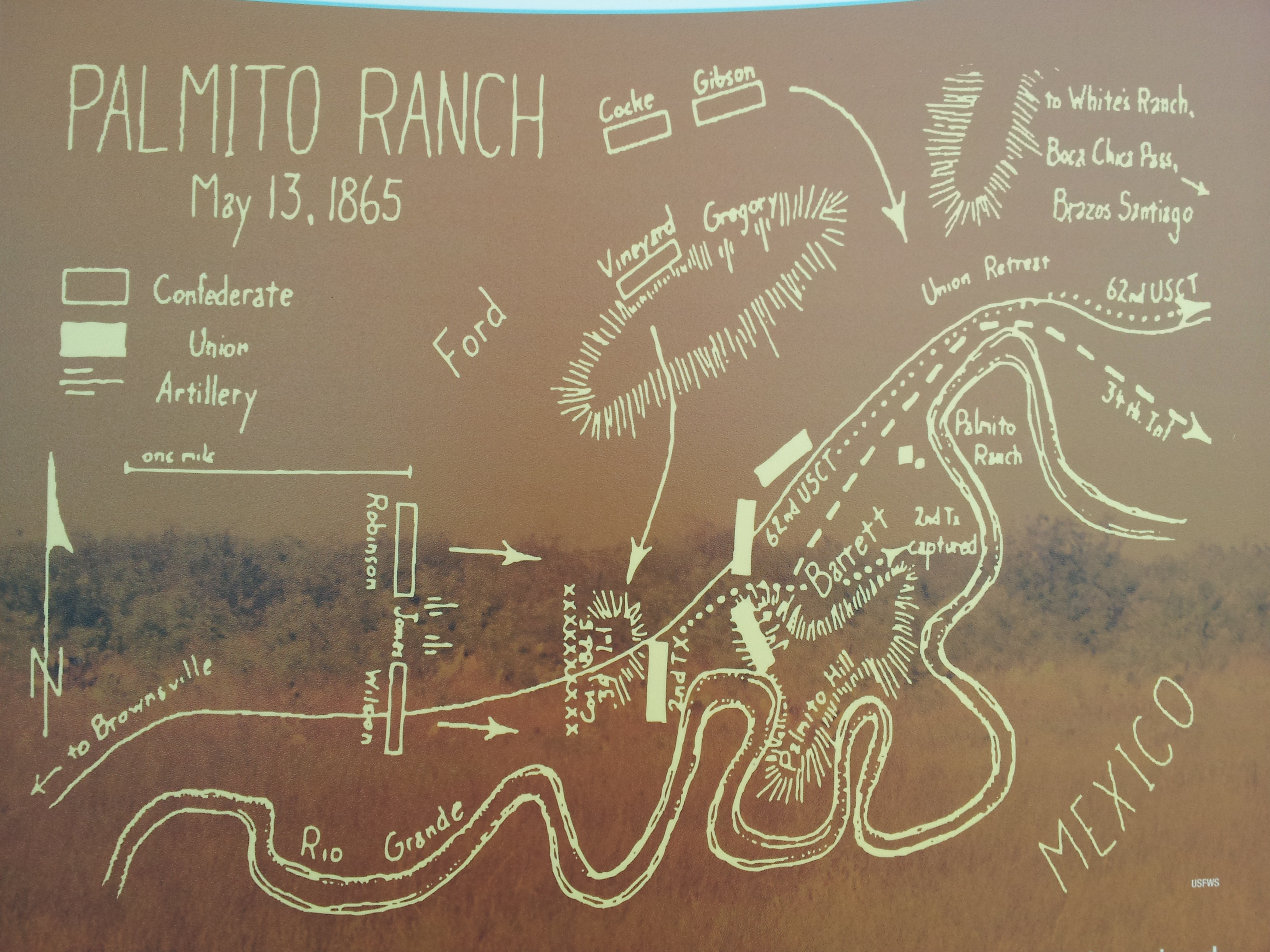 |
| Lincoln University, Jefferson City, MO Statue Honoring the 62nd and 65th United States Colored Infantries |
united-states-colored-troops link
Warrensburg resident Martin Divers, the son of slaves Booker and Isabelle Divers. Martin enlisted as a private at age 18 at Benton Barracks on December 3rd, 1863.
Warrensburg resident Martin Divers, the son of slaves Booker and Isabelle Divers. Martin enlisted as a private at age 18 at Benton Barracks on December 3rd, 1863.
 |
| Camp Benton - Benton Barracks St. Louis 1861 |
Martin served in the Infantry in the United States Colored Troops, 62nd Regiment United States Colored Troops, and Battalion A. They participated in the last major engagement of the Civil War at Palmetto Ranch, Texas on May 15, 1865. Martin Divers returned to Missouri, but was eventually buried in the soldier’s cemetery at Fort Leavenworth Kansas.
 |
US Colored Troops medal 1865 Smithsonian Museum |
By Emily List/Richmond News Staff
St. Louis – Dec. 3, 1863. A man walks up to the stand to enlist. The recruiter looks long and hard at him. The young man is very dark but has the most striking hazel eyes. The man says he’s from Warrensburg, but the recruiter wants to know more. The man hesitates. He doesn’t want to say he’s a slave, and he’s not exactly sure how old he is. The recruiter is annoyed and writes down that the 5-foot-4 colored man in front of him is an 18-year-old farmer.
 |
| Camp Benton - Benton Barracks, St. Louis, MO 1861 Oct 12 |
Martin Divers, suddenly went from slave to private in the First Regiment of Missouri Colored Infantry, which later became the 62nd U.S. Regiment of Colored Infantry. Martin, along with nearly 8,400 black Missourian soldiers, fought in battles in Tennessee, Louisiana, Texas and Alabama. His life would later become part of Richmond’s history.
 |
Previously unidentified African American soldier in Union uniform with wife and two daughters Source: Library of Congress, Reproduction Number: LC-DIG-ppmsca-36454 |
But just because he was a soldier now, Martin was far from equal from his fellow white soldiers. He was treated differently, and his weapons were poor quality and uniform was in bad shape. Martin looked at it thinking that at least two other men had died in that suit before it got to him. By the end of the war, nearly 40,000 black soldiers died in battle or from infection or disease. Divers considered himself lucky. Not only did he survive the war, but only suffered a few days of diarrhea in 1864.
But why did Martin, along with thousands of other African Americans, enlist two years after the war had already begun?
When the Civil War broke out, President Lincoln had trouble deciding whether to recruit black soldiers. Eleven slave states had already seceded from the United States. There were four more “border” states that allowed slavery: Missouri, Kentucky, Maryland, and Delaware. Lincoln was afraid that if he allowed black men to fight – thus emancipating them – those last four border slave states would secede too. He hoped that the war could be won quickly without using African American soldiers.
What Lincoln didn’t realize was how hard the Confederate Army would fight. Hundreds of soldiers from both sides were killed and wounded, but African Americans were still not allowed to fight. Union officers were even trying to form regiments of black volunteers, but the War Department forced a stop to it.
 |
| Martin Divers Gravesite Ft. Leavenworth, KS
Father, Booker Divers, Buried Warrensburg, Missouri, Roop Cemetery
"An ex-slave he lived to be a much respected citizen"
"Aged About 73"
Died April 8, 1888
|
 | ||||||||||||||
| The men in this picture are from Company E, 4th United States Colored Infantry. Theirs was one of the detachments assigned to guard the nation's capital during the American Civil War, circa 1864 1st Missouri Regiment of Colored Infantry
The First Missouri Regiment of Colored Infantry was an African-American infantry regiment
that served in the Union Army during the American Civil War. Redesignated as the 62nd Regiment of U.S. Colored Troops on March 11, 1864.
Service
The Regiment was organized at Benton Barracks, in St. Louis, Missouri, December 7–14, 1863. Attached to District of St. Louis, Mo., to January 1864. Designation changed to 62nd Regiment United States Colored Troops March 11, 1864. Ordered to Port Hudson, Louisiana. District of Baton Rouge, La.,
Dept. of the Gulf, to June 1864. Provisional Brigade, District of Morganza, Dept. of the Gulf, to September 1864. 2nd Brigade, 1st Division, United States Colored Troops, District of Morganza, Dept. of the Gulf, to September 1864. Port Hudson, La., Dept. of the Gulf, to September 1864.
Brazos Santiago, Texas, to October, 1864. 1st Brigade, 2nd Division, United States Colored Troops, Dept. of the Gulf, to December 1864. Brazos Santiago, Texas, to June 1865. Dept. of Texas to March 1866.
Detailed Service
Ordered to Baton Rouge, La., March 23, 1864, and duty there till June. Ordered to Morganza, La., and duty there till September. Expedition from Morganza to Bayou Sara September 6–7. Ordered to Brazos Santiago, Texas, September, and duty there till May 1865.
Expedition from Brazos Santiago May 11–14. Action at Palmetto Ranch May 12–13, 1865. White's Ranch May 13. Last action of the war.
Duty at various points in Texas till March 1866. Ordered to St. Louis via New Orleans, La. Mustered out March 31, 1866.
Founding of Lincoln University
One of the soldiers' most important achievements came at the end of the war. Between duties, and after the termination of hostilities, soldiers of the 62nd and 65th U.S. Colored Troops had been learning to read and write. The troops of these three regiments agreed that they wished to continue their studies as civilians. The soldiers and their officers signed resolutions pledging to work to establish a school "for the special benefit of free blacks". Troops of the 62nd U.S.C.T. were especially energetic in working towards this goal, raising $4,000 to support the establishment of the planned educational institution. This effort eventually lead to the opening of the Lincoln Institute (now Lincoln University) in Jefferson City, Missouri on September 16, 1866
Battle of Palmito Ranch
| ||||||||||||||

The Battle of Palmito Ranch, also known as the
Battle of Palmito Hill and the Battle of Palmetto Ranch,was fought between Union Army and Confederate States
Army forces on May 12–13, 1865 near Brownsville, Texas.
It was the last land battle of any size or significance of the
The following material is from first-hand and published sources. They are recounts of the role of Hispanic Confederate veterans and the treatment of black POWs in South Texas.
There were Hispanic Confederate veterans at Fort Brown in Brownsville and on the field of Palmito Ranch. Col. Santos Benavides, who was the highest ranking Hispanic in either army, led between 100 and 150 Mexicans in the Brownsville Campaign in May 1865.
"Some of the Sixty-Second Colored Regiment were also taken. They had been led to believe that if captured they would either be shot or returned to slavery. They were agreeably surprised when they were paroled and permitted to depart with the white prisoners. Several of the prisoners were from Austin and vicinity. They were assured they would be treated as prisoners of war. There was no disposition to visit upon them a mean spirit of revenge."-Colonel John Salmon Ford, May 1865.
When Colonel Ford surrendered his command following the campaign of Palmito Ranch he urged his men to honor their paroles. He insisted that "The negro had a right to vote."
Private John J. Williams of the 34th Indiana was the last fatality during the Battle at Palmito Ranch, making him likely the final combat death of the war. Fighting in the battle involved Caucasian, African-American, Hispanic, and Native American troops
| Battle of Palmito Ranch | |||||||
|---|---|---|---|---|---|---|---|
| Part of the American Civil War | |||||||
 Sketch map of battle | |||||||
| |||||||
| Belligerents | |||||||
| Commanders and leaders | |||||||
| Theodore H. Barrett | John "Rip" Ford | ||||||
| Units involved | |||||||
| 2nd Texas United States Cavalry (dismounted) 62nd Regt U.S. Colored Troops 34th Indiana Veteran Volunteer Infantry | 2nd Texas Confederate Cavalry Regiment Gidding's Regiment Anderson's Battalion Benavides' Regiment French Foreign Legion(Alleged) Second Mexican Empire (Alleged) | ||||||
| Strength | |||||||
| 500 | 300 | ||||||
| Casualties and losses | |||||||
| 4 killed 12 wounded 101 captured | 5–6 wounded 3 captured | ||||||
Benton Barracks
One Michigan cavalryman stationed at Benton Barracks, also called Camp Benton, described it as a “spacious camp” with two rows of barracks a mile long each and two more barracks one-third of a mile long. There were two parade grounds—one a mile by one-third of a mile and another 70 acres square. All of the buildings—soldiers’ and officers’ quarters, warehouses, and stables—were whitewashed to give them a clean appearance. Built on land formerly occupied by the state fairgrounds, the camp utilized an existing amphitheater by converting it into a hospital that could accommodate 2,500 patients. A contraband camp there held thousands of refugee slaves during the war.
Honoring US Colored Troops from Missouri
 |
| Glasgow, Missouri |
By
1863, the recruitment of black men to join the Union Army was fervent.
The Emancipation Proclamation issued in January 1863, was directed
exclusively to the states that had seceded from the Union. Therefore
border states like Maryland, Kentucky and Missouri were not included.
So technically, slaves in Missouri were not affected by the
proclamation. Prior to the official establishment of the Bureau of
Colored Troops, fugitive slaves were not officially recruited in
Missouri into the Union Army.
However,
once Union Army recruitment of black soldiers had begun in earnest,
slaves were no longer returned to their owners, if runaways had been
found. So therefore, in Missouri as Federal forces had advanced, slaves
in Missouri, like their brethren in the deep south, fled to the Union
lines, and when opportunity came, they eagerly enlisted. Some were
possibly inspired by the presence of black Union men as early as 1862,
when the 1st Kansas Colored became involved in the Battle of Island Mound. They would become the first black soldiers to engage the enemy.
18th US Colored Infantry
Organized in
Missouri at large February 1 to September 28, 1864. Attached to
District of St. Louis, Mo., Dept. of Missouri, to December, 1864.
Unassigned, District of the Etowah, Dept. of the Cumberland, December,
1864. 1st Colored Brigade, District of the Etowa, Dept. of the
Cumberland, to January, 1865. Unassigned, District of the Etowah, Dept.
of the Cumberland, March, 1865. 1st Colored Brigade, Dept. of the
Cumberland, to July, 1865. 2nd Brigade, 4th Division, District of East
Tennessee and Dept. of the Tennessee, to February, 1866.
Service--Duty
in District of St. Louis, Mo., and at St. Louis until November, 1864.
Ordered to Nashville, Tenn., November 7. Moved to Paducah, Ky., November
7-11, thence to Nashville, Tenn. Occupation of Nashville during Hood's
investment December 1-15. Battles of Nashville December 15-16. Pursuit
of Hood to the Tennessee River December 17-28. At Bridgeport, Ala.,
guarding railroad until February, 1865. Action at Elrod's Tan Yard
January 27. At Chattanooga, Tenn., and in District of East Tennessee
until February, 1866. Mustered out February 21, 1866.
62nd US Colored Infantry
Organized March
11, 1864, from 1st Missouri Colored Infantry. Attached to District of
St. Louis, Dept. of Missouri, to March, 1864. District of Baton Rouge,
La., Dept. of the Gulf, to June, 1864. Provisional Brigade, District of
Morganza, Dept. of the Gulf, to September, 1864. 2nd Brigade, 1st
Division, United States Colored Troops, District of Morganza, Dept. of
the Gulf, to September, 1864. Port Hudson, La., Dept. of the Gulf, to
September, 1864. Brazos Santiago, Texas, to October, 1864. 1st Brigade,
2nd Division, United States Colored Troops, Dept. of the Gulf, to
December, 1864. Brazos Santiago, Texas, to June, 1865. Dept. of Texas to
March, 1866.
Service--Ordered
to Baton Rouge, La., March 23, 1864, and duty there until June. Ordered
to Morganza, La., and duty there until September. Expedition from
Morganza to Bayou Sara September 6-7. Ordered to Brazos Santiago, Texas,
September, and duty there until May, 1865. Expedition from Brazos
Santiago May 11-14. Action at Palmetto Ranch May 12-13, 1865. White's
Ranch May 13. Last action of the war. Duty at various points in Texas
until March, 1866. Ordered to St. Louis via New Orleans, La. Mustered
out March 31, 1866.
65th US Colored Infantry
Organized March
11, 1864, from 2nd Missouri Colored Infantry. Attached to Dept. of
Missouri to June, 1864. Provisional Brigade, District of Morganza, La.,
Dept. of the Gulf, to September, 1864. 2nd Brigade, 1st Division, United
States Colored Troops, District of Morganza, Dept. of the Gulf, to
February, 1865. 1st Brigade, 1st Division, United States Colored Troops,
District of Morganza, La., Dept. of the Gulf, to May, 1865. Northern
District of Louisiana and Dept. of the Gulf to January, 1867.
Service--Garrison
duty at Morganza, La., until May, 1865. Ordered to Port Hudson, La.
Garrison duty there and at Baton Rouge and in Northern District of
Louisiana until January, 1867. Mustered out January 8, 1867.Regiment lost during service 6 Officers and 749 Enlisted men by disease.
67th US Colored Infantry
Organized March
11, 1864, from 3rd Missouri Colored Infantry. Attached to Dept. of
Missouri to March, 1864. District of Port Hudson, La., Dept. of the
Gulf, to June, 1864. Provisional Brigade, District of Morganza, Dept. of
the Gulf, to September, 1864. 2nd Brigade, 1st Division, United States
Colored Troops, District of Morganza, Dept. of the Gulf, to February,
1865. 1st Brigade, 1st Division, United States Colored Troops, District
of Morganza, Dept. of the Gulf, to May, 1865. Northern District of
Louisiana, Dept. of the Gulf, to July, 1865.
Service--Moved
from Benton Barracks, Mo., to Port Hudson, La., arriving March 19,
1864, and duty there until June. Moved to Morganza, La., and duty there
until June, 1865. Action at Mt. Pleasant Landing, La., May 15, 1864
(Detachment). Expedition from Morganza to Bayou Sara September 6-7,
1864. Moved to Port Hudson June 1, 1865. Consolidated with 65th
Regiment, United States Colored Troops, July 12, 1865.
68th US Colored Infantry
Organized
March 11, 1864, from 4th. Missouri Colored Infantry. Attached to
District of Memphis, Tenn., 16th Corps, Dept. of the Tennessee, to June,
1864. 1st Colored Brigade, Memphis, Tenn., District of West Tennessee,
to December, 1864. Fort Pickering, Defenses of Memphis, Tenn., District
of West Tennessee, to February, 1865. 3rd Brigade, 1st Division, United
States Colored Troops, Military Division West Mississippi, to May, 1865.
1st Brigade, 1st Division, United States Colored Troops, District of
West Florida, to June, 1865. Dept. of Texas to February, 1866.
SERVICE--At
St. Louis, Mo., until April 27, 1864. Ordered to Memphis, Tenn., and
duty in the Defenses of that city until February, 1865. Smith's
Expedition to Tupelo, Miss., July 5-21, 1864. Camargo's Cross Roads,
near Harrisburg, July 13. Tupelo July 14-15. Old Town Creek July 15. At
Fort Pickering, Defenses of Memphis, Tenn., until February, 1865.
Ordered to New Orleans, La., thence to Barrancas, Fla. March from
Pensacola, Fla., to Blakely, Ala., March 20-April 1. Siege of Fort
Blakely April 1-9. Assault and capture of Fort Blakely April 9.
Occupation of Mobile April 12. March to Montgomery April 13-25. Duty
there and at Mobile until June. Moved to New Orleans, La., thence to
Texas. Duty on the Rio Grande and at various points in Texas until
February, 1866. Mustered out February 5, 1866.
Battles Fought in Missouri Involving US Colored Troops
There
were not many battles involving black soldiers fought in Missouri.
Most of the regiments organized in the state were sent to other places
such as Mississippi, Louisiana and Tennessee. The two most significant
battles in which black Union Soldiers, were Island Mound and Glascow
Missouri. Those battles would involve soldiers from other states, with
exception of Glascow.
Missouri Civil War Battles involving black soldiers
Glascow, Missouri October 15, 1864 involving the 62nd US Colored Infantry
Island Mound, Missouri 1962 involving the 1st Kansas Colored Infantry (re-designated as 79th US Colored)
Sherwood, Missouri May 18, 1863 involving the 79th US Colored Infantry (formerly 1st Kansas Colored)
Military Service Muster In Document of US Colored soldier of Missouri





3 comments:
I appreciate this page, interesting. But either the tile frames of the pictures in the background or the text color on them makes it hard to read.
...after reloading page, it seems that its a margin issue..the text runs off of the right margin and scrolling won't work, in the "1st colored regiment" section.
Really like the page tho. I'm gonna keep reading.
Thank you for you comments, I think we fixed the problem! regards.
Post a Comment